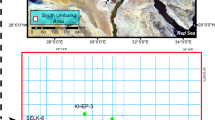To address the challenge of stratigraphic correlation and division in exploration and development caused by the diverse sediment sources, complex internal structure, and rapid lateral changes of gravelly fan deposits in the Guojuzi depression steep slope, a comprehensive technique for sequence-based stratigraphic correlation and division of complex reservoirs has been proposed. This technique includes several aspects such as the methodological basis, correlation method, and modification method. The methodological basis involves multi-well precise calibration of target layers, determination of high-frequency sequence stratigraphy division scheme, and seismic constraints. The correlation method includes several techniques such as stratigraphic correlation under the control of stratigraphic unconformity structure, sedimentary pattern control, facies sequence comparison, marker bed method, and contour stratigraphy correlation. The modification method mainly includes stratigraphic thickness method, fluid property method, and structural method, which are used to correct the results of stratigraphic correlation. Based on this technique, a high-order sequence stratigraphic framework has been established, which involved the precise calibration of target layers using seismic, stratigraphic structure, sedimentary facies, facies sequence, marker beds, and contour constraints, followed by the application of correction methods such as stratigraphic thickness, fluid property, and structural analysis. A total of 26 five-level sequence stratigraphic frameworks have been established through high-frequency sequence correlation.








Similar content being viewed by others
References
Cao Y.C., Jiang Z.X., Xia, B., et al. Characters and controling factors of trseuencein lacustrine deposits of rftbasin: an example from the dongying depression, eastern china. Geological science, 2004,39(01), 111-122.
Hu S.Q., Guo, W.P., Yang, F.G., et al. Study on influential factors of Terri genous Sequence for mition and Development in Fault depressed Lacustri ne Basin. Acta sedimentologica sinica, 2001, 19(02), 257-262.
Yang W.L., Jiang Z.X., Cao Y.C., et al. Characters and formation T-R sedimentary sequences of Sha-III and the lower Sha-II members in dongying depression. Journal of China University of Petroleum (Edition of Natural Science), 2003, 27(03), 6-9.
Cai Q.S. Sequence stratigraphic framework and sedimentary system of small continental faulted lacustrine basin: A case study of Shahezi Formation in the north of Xujiaweizi, Songliao Basin. Hubei: Yangtze University, 2017.
Cao Y.C., Jiang Z.X., Wang L.Q., et al. Classification and identification of sequence stratigraphic in a rift lake basin. Journal of China University of Petroleum (Edition of Natural Science), 1996, 20(04), 1-5.
Yang M.H., Liu C.Y. Types, Textures and Series of the Continental Sequences and Model of Sedimentary Basin-Fill in Rift Basin:ACase Study from Jizhong Basin, China. Acta sedimentologica sinica, 2002, 20(02), 222-228.
Cao Y.C. Sequence stratigraphy of faulted lacustrine basin. Geological Publishing House. 2005, 26-88.
Zhao X.D., Yang S.C., Chen N.N., et al. Establishment of Stratigraphic Framework on Sedimentological Interviewing of the Jurassic Shuixigou Group in Jishen-1 Area, Turpan-Hami Basin. Geological Review, 2013, 59(4), 656-664.
Kong X.Y., Yu J.C., Li S.F. Fine stratigraphic correlation method and its application in complicated fault-block oilfield. Lithologic Reservoirs, 2009, 21(1), 120-124.
Luo D.M., Tan X.Q., You Y.C., et al. Stratigraphic division and correlation in areas with complicated sedimentary environment-a case study of Daniudigas field in the Ordos Basin, Oil & Gas Geology, 2008, 29(1), 38 -44.
Liu B., Zhao H.Q., Yu H.Y. Discussion on the two methods of detailed reservoir correlation. Petroleum Exploration and Development, 2001, 28 (6), 94-96.
Yuan X.T., Shen P.P. Continental strata relation of high-resolution sequence in resolution sequence in reservoir development phase. Acta Petrolei Sinica, 2007, 28 (6), 87-91.
Zhao H.Q. High resolution sequence stratigraphy correlation and Chinese subzone correlation. Petrolcum Geologyge Oilfield Development in Daqing, 2005, 2(1), 5-12.
Ma L., Zhou J.Y., Wang X.L., et al. The Eocene Stratigraphic Division and Correlation of The Chaluhe Depression in The Yitong Basin. Petroleum Geology & Experiment, 2008, 30(3), 260-265.
Yuan L.H., Liu H., Li J.H. The Application of Well-seismic Integration Calibration Technique in Stratigraphic Correlation of Haila’er Basin. Journal of Oil and Gas Technology, 2012, 34(1), 63-64.
Liu Z., Wang D.W., Wu H., et al. Research on isochronic subzone correlation of non-marine reservoir by seismic data: a case study in SZ36-1 oilfield, Bohai Bay Basin. Earth Science Frontiers, 2008, 15(1), 133-139.
Luo Q., Zheng D.S., Sun H.Z. Geological seismic Comprehensive Stratigraphic Division and Correlation. Journal of Jianghan Petroleun Institute, 2001, 23(1), 26-30.
Gu J.Y., Guo B.C., Zhang X.Y. Sequence stratigraphic framework and model of the continental basins in China. Petroleum Exploration and Development, 2005, 32(5), 11-15.
Xiang K., Zhao Y.F., Wang J.F. Stratigraphic division and correlation using various approaches-case of stratigraphic correlation of heavy oil, Chunfeng oilfield, Junggar Basin. Petroleum Geology and Recovery Efficiency, 2011, 18(5), 1-5.
Li W.C., Yang X.P., Wang K.J., et al. Method and Development Model of Strata Correlation on Residual Strata of Chunguang Oilfield. Journal of Southwest Petroleum University (Science & Technology Edition), 2016, 38(3), 37-45.
Ji Y.L., Wu S.H., Zhang R. Recognition of auto-cycle and its role in strata correlation of reservoirs. Journal of China University of Petroleum, 2012, 36(4), 1-6.
Author information
Authors and Affiliations
Corresponding author
Additional information
Translated from Khimiya i Tekhnologiya Topliv i Masel, No. 3, pp. 149–157 May – June, 2023.
Rights and permissions
Springer Nature or its licensor (e.g. a society or other partner) holds exclusive rights to this article under a publishing agreement with the author(s) or other rightsholder(s); author self-archiving of the accepted manuscript version of this article is solely governed by the terms of such publishing agreement and applicable law.
About this article
Cite this article
Zhao, D., Yan, Y. & Wang, Y. Comprehensive Reservoir Comparison Technique for Complex Reservoirs. Chem Technol Fuels Oils 59, 625–637 (2023). https://doi.org/10.1007/s10553-023-01563-z
Published:
Issue Date:
DOI: https://doi.org/10.1007/s10553-023-01563-z




